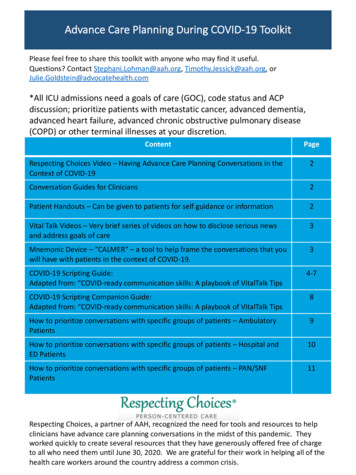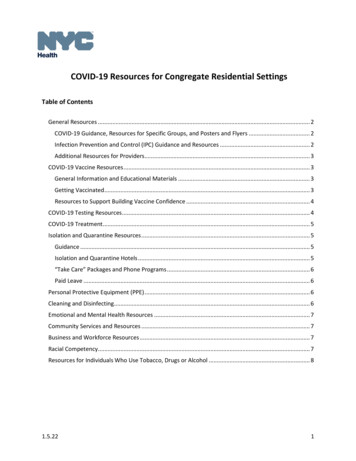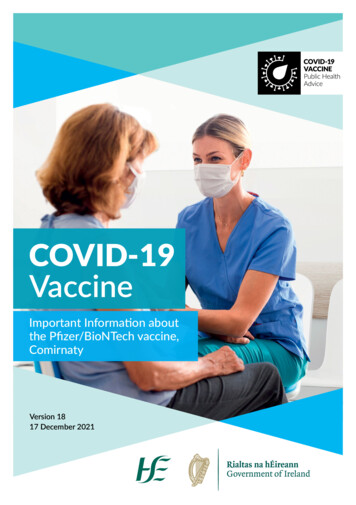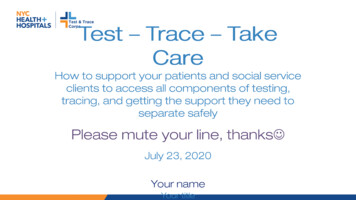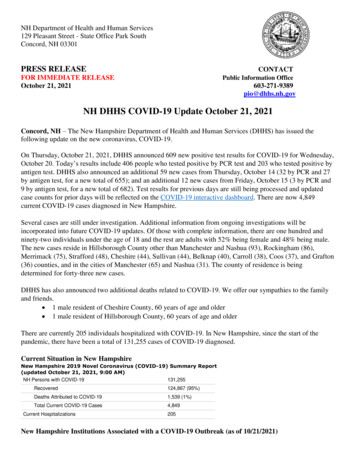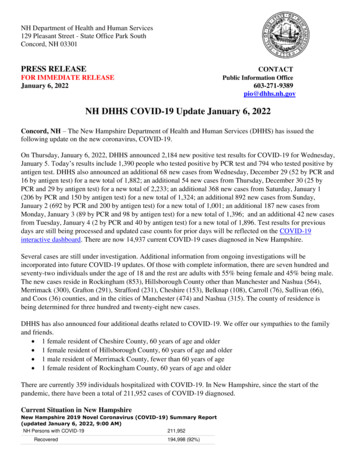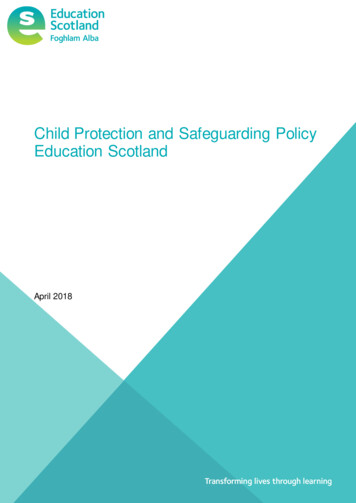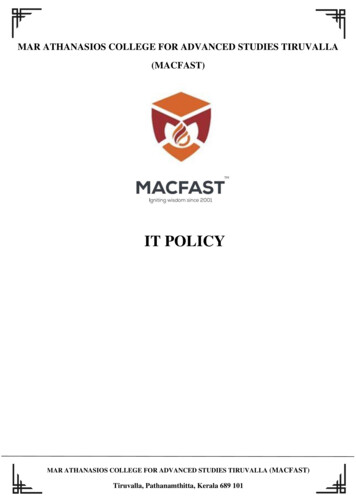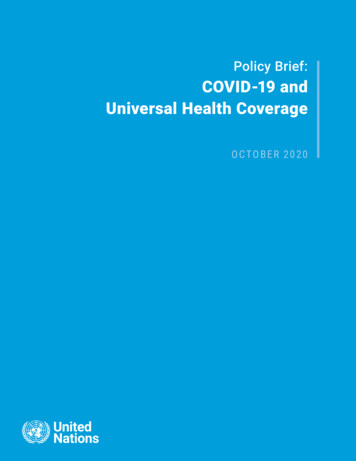
Transcription
Policy Brief:COVID-19 andUniversal Health CoverageOCTOBER 2020
Executive summaryIn the space of nine months, COVID-19 hascommunities receive the health services theyspread to more than 190 countries, with overneed without undue financial hardship. However,30 million cases reported. Over one millionat least half of the world’s population still do notlives have been lost. The pandemic has laidhave full coverage of essential health services,bare long-ignored risks, including inadequateand over 800 million people spend at leasthealth systems, gaps in social protection and10 per cent of their household budgets to pay forstructural inequalities. It has also broughthealth.1 It will be important to remove as muchhome the importance of basic public health,as possible financial barriers to accessing healthand strong health systems and emergencyservices. This is challenging during an economicpreparedness, as well as the resilience ofrecession, but COVID-19 has shown that effec-a population in the face of a new virus ortive epidemic control benefits the economy. Itpandemic, lending ever greater urgency to thehas also exposed the down sides of financingquest for universal health coverage (UHC).health coverage primarily through wage-basedHealth is a fundamental human right, and universal health coverage is a critical tool for achievinghealth for all. Universal health coverage isdefined as a situation where all individuals andcontributions. In the context of a global economic crisis where unemployment increases,and where entitlement to services is linked tosuch contributions, access to health services isreduced at the time people need it the most.What is universal health coverage?Universal health coverage means that all individuals and communities receive the health servicesthey need without undue financial hardship. The goal of universal health coverage is threefold: Equity in access: everyone who needs health services should get them, not only those who canpay for them Sufficient quality: health services should be good enough to improve the health of those receiving services No undue financial risk: The cost of using health services should not put people at risk of financial harm.The idea of universal health coverage is based on the WHO constitution of 1948 declaring health afundamental human right and on the Health for All agenda set by the Alma Ata Declaration in 1978.All United Nations Member States have reaffirmed their commitment to try to achieve universal healthcoverage by 2030, as part of the Sustainable Development Goals (A/RES/74/2, October 2019).12World Health Organization (WHO), “Universal health coverage (UHC)”, 24 January 2019, available at sal-health-coverage-(uhc).UNITED NATIONS POLICY BRIEF: COVID-19 AND UNIVERSAL HEALTH COVER AGE OCTOBER 2020
The world is now at a critical juncture of theSafe and effective vaccines, diagnostics andCOVID-19 pandemic. After some initial successtherapeutics will also be vital for ending the pan-in suppressing transmission, many countriesdemic and accelerating the global recovery. It hasare now experiencing a resurgence after easingalso become abundantly clear that it is in everyof restrictions. With the flu season approachingcountry’s national and economic self-interestin some part of the world, and with cases andto work together massively to expand access tohospitalizations increasing, many countries findtests and treatments, and to support a vaccinethemselves struggling to strike the right balanceas a global public good — a “people’s vaccine”between protecting public health, protecting per-available and affordable for everyone, every-sonal liberties and keeping their economies going.where. The Access to COVID-19 Tools AcceleratorWith universal health coverage in place, countriescould more effectively and efficiently address(ACT-Accelerator) with its COVAX Facility isthe best global solution for getting us there.the three ways in which the COVID-19 crisis isLonger term, pandemic preparedness anddirectly and indirectly causing morbidity andresponse can be seen as a global public goodmortality: the first is due to the virus itself, thewith commensurate global and national-levelsecond is due to the inability of health systemsinvestments. It requires a standardized outbreakto provide ongoing essential health services, andalert system linked to concrete actions bythe third is linked to its socioeconomic impact.national and local health authorities. As of now,We have witnessed that the virus poses thegreatest risk to those groups that were alreadyin situations of greater vulnerability: those livingin poverty, older people, those with pre-existinghealth conditions, women, children, migrantsand those who have been forcibly displaced. In amatter of months, entire regions that were makingprogress on eradicating poverty and narrowinginequality have been set back years. Humandevelopment has gone backwards for the firsttime since we began to measure it in 1990.There can no longer be any question about thelinks between public health and the broaderresilience of economies and societies. COVID-19has reinforced existing evidence that investmentsin health have long-term returns, while underinvestment has potential devastating large-scaleglobal social and economic effects that couldlast for years. The pandemic is costing theglobal economy 375 billion a month and 500million jobs since the crisis erupted. The focusneeds to remain on addressing the root causeof the economic crisis — which is COVID-19. Inthis regard, WHO has provided comprehensiveguidance on effective public health measures.3only one third of countries have put in place thecapacities for their public health emergencymanagement systems as required under theInternational Health Regulations (2005).Coming out of the COVID-19 pandemic will requirea whole-of-govern ment, whole-of-society and aglobal coordinated approach. The lessons learnedcall for universal health coverage that ensuresequal access to quality health care withoutfinancial risks for everyone and that effectivelyprotects societies from another health crisis withits devastating effects on lives and livelihoods.All United Nations Member States have agreedto try to achieve universal health coverage by2030, as part of the Sustainable DevelopmentGoals and in keeping with the 2019 PoliticalDeclaration on Universal Health Coverage.There are clear steps that can be taken in thecontext of the COVID-19 response and recoverymeasures to address the weaknesses that thepandemic has exposed and to invest in moreresilient public health in the future. Ultimately,it is a political choice to ensure a pandemic ofthis scale and impact does not occur again.UNITED NATIONS POLICY BRIEF: COVID-19 AND UNIVERSAL HEALTH COVER AGE OCTOBER 2020
RECOMMENDED ACTIONS1. URGENTLY CONTROL FURTHER T RANSMISSION OF COVID-19:4. ACHIEVE UNIVERSAL HEALTHCOVERAGE: Continue to strengthen public health measures to reduce local COVID-19 transmissionare fundamental to protecting and promotingto zerohealth and well-being, known as “commonMake universal provision for COVID-19 test-goods for health”ing, isolating and contact tracing Invest in core health systems functions thatEnsure access to care for COVID-19 patients Suspend user fees for COVID-19 and otheressential health care.to reduce number of deaths.2. PROTECT DELIVERY OF OTHER ESSENTIAL HEALTH SERVICES. To minimizemorbidity and mortality, priority healthservices need to continue to be deliveredduring the acute phase of the COVID-19pandemic.5. STRENGTHEN NATIONAL AND GLOBALPANDEMIC PREPAREDNESS AND AIMFOR HEALTHY SOCIETIES FOR THEFUTURE.3. MASSIVELY EXPAND ACCESS TO NEWRAPID DIAGNOSTICS AND TREATMENTS AND ENSURE FUTURE COVID-19VACCINES ARE A GLOBAL P UBLICGOOD WITH EQUITABLE ACCESS FOR E VERYONE, EVERYWHERE: Take a global approach to ensuring equitableaccess to new COVID-19 tools by fully fundingthe Access to COVID-19 Tools Accelerator(ACT-Accelerator) Urgently address the spread of misinformation and false rumours about vaccine safety.4UNITED NATIONS POLICY BRIEF: COVID-19 AND UNIVERSAL HEALTH COVER AGE OCTOBER 2020
1. Impact of COVID-19 onhealth and pandemic responseWithin just nine months, COVID-19 has spreadpopulation, 1.7 billion people, have at least one ofto more than 190 countries. By the end ofthese underlying conditions, whereas 350 millionSeptember 2020, the world had recorded overpeople (4 per cent of the global population) are30 million cases, and over 1 million peopleat high risk of severe COVID-19.3 The share ofhad lost their lives. COVID-19 is directly andthe population at increased risk is highest inindirectly causing morbidity and mortalitycountries with older populations, African coun-in three ways: (1) due to the virus itself,tries with high HIV/AIDS prevalence, and small(2) due to the inability of health systems toisland nations with high diabetes prevalence.provide ongoing essential health services,(3) due to its socioeconomic impact.COVID-19 often hits hardest those who can leastafford it: the old, those with chronic disease, orthose in poor living conditions. Older persons1.1.T HOSE MOST VULNERABLETO COVID-19 AND NEEDFOR A GLOBAL RESPONSEDepending on the age structure of the population, about 5 to 15 per cent of COVID-19 patientswill develop critical complications that requiremechanical ventilation, and 15 to 20 per cent ofpatients will have severe symptoms that requireoxygen therapy or other inpatient interventions.2Known risk factors for severe COVID-19 diseaseare being over 60 years of age, having hypertension, diabetes, cardiovascular disease, chronicrespiratory disease or immunocompromisingconditions. About one fifth of the world’sin long-term care facilities have high morbidityand mortality rates as well as high rates of staffabsence due to COVID-19. In several EuropeanUnion countries, deaths among residents haveaccounted for over half of all COVID-19-relateddeaths.4 Persons living in confined living spaces,whether in crowded settlements, refugees,migrants, prisons, are also at high risk.Healthcare workers are at high risk of COVID-19infection because of more frequent contactwith COVID-19 cases (see box 1.1). Frontlineworkers in essential occupations, such as inpublic transport, food production, law enforcement, also face greater exposure. A number ofchronic conditions add to the susceptibility ofCOVID-19 infection and increase the adverse2WHO, “Operational considerations for case management of COVID-19 in health facility and community”, 19 March 2020, available /331492/WHO-2019-nCoV-HCF operations-2020.1-eng.pdf?sequence 1&isAllowed y.3Andrew Clark and others, “Global, regional, and national estimates of the population at increased risk of severe COVID-19 due to underlying health conditions in 2020: a modelling study”, The Lancet, 15 June 2020, available at www.thelancet.com/action/showPdf?pii S2214-109X%2820%2930264-3.4European Centre for Disease Prevention and Control, “Epidemiology of COVID-19”, 15 July 2020, available at demiology.5UNITED NATIONS POLICY BRIEF: COVID-19 AND UNIVERSAL HEALTH COVER AGE OCTOBER 2020
consequences. For example, there are findingsWomen play a disproportionate role in respond-that HIV infection increased COVID-19 mortalitying to the pandemic, as healthcare workers,in South Africa’s Western Cape province 2.5-fold.caregivers and community mobilizers. Globally,Anxiety and depression appear to be commonwomen make up 70 per cent of the health workamongst people hospitalized for COVID-19, withforce, 5 and in some countries, infections amongone hospitalized cohort from Wuhan, China,female health workers are twice that of theirindicating over 34 per cent of people experi-male counterparts.6 In the home, women doencing symptoms of anxiety and 28 per centthree times as much unpaid care work as men.experiencing symptoms of depression. ThisWhen health systems are overloaded, a greaterhighlights the importance of mental health ser-burden is placed on care in the home and thatvices being considered essential components ofburden lands largely with women and girls.the national response to COVID-19, as outlined inthe Policy Brief launched in May 2020 COVID‑19and the Need for Action on Mental Health.FIGURE 1.1. PREVALENCE OF RISKS FACTORS FOR SEVERE DISEASE,BY AGE AND SEX AND BY REGION 202070 65-69 60-64 55-59 50-54 40-49 30-39 20-29 200%20%Prevalence40%60%Prevalence0% 10% 20% 30% 40%80%FAfricaMFAsiaMFEuropeMFMLatin American and the CaribbeanFNorthern AmericaMFOceaniaMFMFFemaleMFMaleMMultipleSingle5M. Boniol and others, “Gender Equity in the Health Workforce: Analysis of 104 Countries”, Health Workforce Working Paper 1, WHO, 2019;for e.g the cases of Spain and the US where over 70 per cent of infected health-care workers were women, see UN-Women,“COVID-19: Emerging gender data and why it matters”, 26 June 2020, available at ng-gender-data-and-why-it-matters.6UN-Women, “COVID-19 And Women’s Leadership: From An Effective Response to Building Back Better”, Policy Brief no. 18, 2020, available at id-19-and-womens-leadership-en.pdf?la en&vs 409.6UNITED NATIONS POLICY BRIEF: COVID-19 AND UNIVERSAL HEALTH COVER AGE OCTOBER 2020
Women’s role and burden in the pandemic arenot reflected at the decision-making table. Asof 1 January 2020, three quarters of the world’sparliamentary seats are held by men. Only25 per cent of the world’s health ministers arewomen, and women hold just 25 per cent ofsenior roles in health institutions. Meanwhile,72 per cent of executives of global health organizations are men. Women’s roles need to be7extended beyond the frontlines to participatingin the design, implementation and monitoringof national COVID-19 responses. Evidenceshows where women are Heads of State andGovernment, the response to COVID-19 hasbeen perceived as particularly effective.8BOX 1.1. INCLUSION OF REFUGEESRefugees, internally displaced personsand stateless persons in vulnerablesituations are particularly exposed to thehealth impact of COVID-19. The risks arecompounded in fragile, conflict-affectedand humanitarian settings, in whichlarge numbers of refugees and internallydisplaced persons live in overcrowded orunsanitary conditions where COVID-19can easily spread. More than 85 per centof refugees are hosted in low to middle-income countries. The Global CompactNoting that most of the frontline workers areon Refugees calls for the internationalwomen, support to such workers should takecommunity to ensure that refugees andwomen’s needs in to account. Such measurestheir host communities are not left behindmay include offering flexible working arrange-in a country’s progress towards thements, free transportation, extra payments andSustainable Development Goals, includ-services, also recognizing women’s increaseding by supporting refugee inclusion inburden of unpaid care work during the pandemic.national health systems.9 The SecretaryGeneral’s Policy Brief on COVID-19 andPeople on the Move further called fortheir inclusion in national COVID-19response plans, protection of their humanrights, and recognition of their enormouspotential to contribute to solutions.7UN-Women, “COVID-19 And Women’s Leadership”, see for e.g. Denmark, Ethiopia, Finland, Germany, Iceland, New Zealand, and Slovakia.8UN-Women, “Rapid gender assessment of the situation and needs of women in the context of COVID-19 in Ukraine”, 2020, available der%20assessment engmin.pdf?la en&vs 3646.9United Nations High Commissioner for Refugees, “Global Compact on Refugees”, available at 7UNITED NATIONS POLICY BRIEF: COVID-19 AND UNIVERSAL HEALTH COVER AGE OCTOBER 2020
BOX 1.2. EXAMPLES OF GOOD PRACTICEIN ADDRESSING THE HEALTHIMPACT OF COVID-19 ONREFUGEES AND IDPS In Ghana and Turkey, refugees are fullyincluded in national health systems on par IN ADDRESSING THE SOCIOECONOMIC FALLOUT OF C OVID-19ON THOSE WHO HAVE BEENFORCIBLY DISPLACED allowing foreign-trained refugee doctors,In Rwanda, urban refugees in Kigali havenurses and others with medical trainingto work during the COVID-19 response. Inbeen included in the national social healthIreland, the Medical Council has announcedinsurance scheme. it would allow refugees and asylum-seekersIn Mauritania, with the support of the Worldwith medical training to provide medicalBank, a transition is underway to build thesupport by taking up roles, including ascapacity of the national system to fullyinclude refugees. Peru, Chile and Argentina recently beganwith nationals.In Peru, temporary health coverage hashealthcare assistants. Guinea and Liberia continue to pay teacherbeen approved for refugees and migrantsincentives during the closure of schools forsuspected of or testing positive forrefugee teachers to ensure continuity ofCOVID-19.States need both financial and technicalsupport in order to implement fully inclusiveHumanitarian actors in Burkina Faso, Chad,income. The South African Government confirmedthat 30 per cent of financial support forpublic healthcare policies. By adoptingsmall convenience shop owners can go tosuch policies, refugee-hosting countriesforeign-owned businesses, including thosemay be able to access humanitarian andowned by refugees.development funding and the possibilityto plan for multi-year projects.Governments around the world have expandedlockdown early experienced fewer deaths in sub-their control measures to reduce the spread ofsequent weeks. Also, the cumulative per-capitaCOVID-19. The measures have included schoolmortality rate from COVID-19 has plateaued atand workplace closing, cancelling public events,different levels in different countries. Some peo-restrictions on gathering size, reducing publicple at particularly high risk, such as those of oldertransport, stay-at-home requirements and restric-ages, may need further shielding from potentialtions on internal movement and internationalexposure to COVID-19 infection. Others, such astravel. Such measures have been effective innonviolent prisoners living in confined spaces,reversing the rising numbers of COVID-19 caseshave been released on a case-by-case base.10and deaths. For instance, countries that went into10 Blavatnik School of Government, University of Oxford, “US Government Response”, 14 September 2020, available at virus-government-response-tracker.8UNITED NATIONS POLICY BRIEF: COVID-19 AND UNIVERSAL HEALTH COVER AGE OCTOBER 2020
Treatment and care decisions need to be basedPatients and their caregivers need to be involvedon medical need and not on discriminatoryin decision-making to the greatest extent possi-factors such as ethnicity, nationality, religion, sex,ble, explaining options and limitations in treat-age, disability or political affiliation. It is essentialment. It is important that treatment and care doesthat patients with similar health problems ornot increase peoples’ financial hardship, whichsymptoms receive equal treatment and care.is a core principal of universal health coverage.FIGURE 1.2. IMPLEMENTATION OF CONTAINMENT ANDPUBLIC HEALTH INTERVENTIONS BY REGION, 2020Index runs from 0 to 100 and signifies the strength of public health response by region.Central and Southern Asia100Eastern and South-Eastern AsiaLatin America and the Caribbean80Northern America and EuropeOceania60Sub-Saharan AfricaWestern Asia and Northern Africa40200MarAprMayJunJulAugSeptSource: World Health Organization.FIGURE 1.3. TREND IN COVID-19 CASES AND DEATHS BY SDG REGION, 2020Deaths per 100,000 population7,000Central and Southern AsiaEastern and South-Eastern Asia6,000Europe5,000Latin America and the Caribbean4,000Northern America3,000Sub-Saharan AfricaOceaniaWestern Asia and Northern Africa2,0001,0000MarAprMayJunJulAugSeptSource: World Health Organization.9UNITED NATIONS POLICY BRIEF: COVID-19 AND UNIVERSAL HEALTH COVER AGE OCTOBER 2020
1.2.I MPACT ON OTHERHEALTH SERVICESThe additional patient load caused by COVID-19threatens the ability of health systems to provide other essential health services. On a localscale this may mean the cancellation of electivesurgeries and other non-urgent procedures,but may also lead to wider effects owing to therestriction of travel, interruption of supply chainsand redeployment of staff.11 The indirect effectscan sometimes outweigh the direct impact ofthe COVID-19 outbreak itself. Already, we haveseen disruptions in 90 per cent of countries. Aswith COVID-19, those who miss out on essentialhealth services are likely to be from poor, disadvantaged groups with poorer access to services.On a global scale, the effects may seriouslyimpair or reverse progress towards theSustainable Development Goals (SDGs).For example, coverage reductions of 9.8 to18.5 per cent of reproductive, maternal and childhealth interventions, such as immunization, anda wasting increase of 10 per cent, could lead tomore than 250,000 additional child deaths andviolence can be expected to occur if lockdownscontinue for at least six months in 114 low- andmiddle-income countries.13 A suspension ofplanned insecticide-treated nets distributionsin 2020, and reduced access to effective antimalarial treatment could lead to an estimated769,000 malaria deaths by the end of 2020.14A global reduction of 25 per cent in expectedtuberculosis detection for 3 months couldincrease tuberculosis deaths by 13 per cent,bringing us back to the levels of tuberculosismortality that we had 5 years ago.15 A sixmonth disruption of antiretroviral therapy couldlead to more than 500,000 extra deaths fromAIDS-related illnesses in sub-Saharan Africa in2020–2021: in 2018, an estimated 470,000 people died of AIDS-related deaths in the region.16COVID-19 can negatively affect outcomesin people with noncommunicable diseasesthrough delays in diagnosis of noncommunicable diseases, such as cancers and heartdisease among others, resulting in moreadvanced stages of disease. Delays in seekingcare for heart attack, stroke and cancerhave been reported in some countries.1712,000 maternal deaths over 6 months in 118To minimize morbidity and mortality, countriescountries. Furthermore, 47 million women mayneed to identify essential health servicesnot be able to access modern contraceptives,that will be prioritized for continuation during7 million unintended pregnancies may occurthe acute phase of the COVID-19 pandemic.and 31 million additional cases of gender-basedHigh-priority categories are listed in box 1.3.181211 WHO, “Maintaining essential health services: operational guidance for the COVID-19 context”, 1 June 2020, available at ntial-health-services-2020.1.12 Timothy Roberton and others, “Early estimates of the indirect effects of the COVID-19 pandemic on maternal and child mortality inlow-income and middle-income countries: a modelling study”, The Lancet: Global Health, vol. 8, No. 7, 1 July 2020, available 14-109X(20)30229-1/fulltext.13 United Nations Population Fund, “Coronavirus Disease (COVID-19) Pandemic”, June 2020, available at PA Global Response Plan Revised June 2020 .pdf.14 WHO, “The potential impact of health service disruptions on the burden of malaria”, 23 April 2020, available at malaria.15 WHO, “Tuberculosis and COVID-19”, Information Note, 12 May 2020, available at osis/infonote-tb-covid-19.pdf?sfvrsn b5985459 18.16 A. Hogan and others “Spiral: Report 19: The Potential Impact of the COVID-19 Epidemic on HIV, TB and Malaria in Low- and MiddleIncome Countries”, 30 April 2020, available at 78670.17 Marion M. Mafham and others, “COVID-19 pandemic and admission rates for and management of acute coronary syndromes inEngland”, The Lancet, vol. 396, No. 10248, 8 August 2020, available at https://doi.org/10.1016/S0140-6736(20)31356-8.18 WHO, “Maintaining essential health services”.10UNITED NATIONS POLICY BRIEF: COVID-19 AND UNIVERSAL HEALTH COVER AGE OCTOBER 2020
FIGURE 1.4. PERCENTAGE CHANGE IN DELIVERIES BORNE IN PUBLIC HEALTHFACILITIES IN EAST AND SOUTHERN AFRICA, 2020 VERSUS 201920-30-40-50BurundiZambiaZimbabweAngolaSouth ar-20Democratic Republic of Congo-10Uganda0Eritrea10-60Source: Regional multi-agency (UNFPA, UNAIDS, UNICEF and WHO) 2gether 4 SRHR Programme.FIGURE 1.5. FALL IN TUBERCULOSIS CASESATTENDING HEALTH FACILITIES IN INDIA, 2019–2020250Thousands of cases200150100500Jan Feb Mar Apr May JunJul Aug Sep Oct Nov Dec Jan Feb Mar Apr May JunTotalJul AugPrivateThe national lockdown started on week 12, partial lifts were initiated on week 16 in some states. Data extracted from the public website of the national real-time tuberculosis surveillance system.Source: 1UNITED NATIONS POLICY BRIEF: COVID-19 AND UNIVERSAL HEALTH COVER AGE OCTOBER 2020
BOX 1.3. SERVICES TO BE PRIORITIZED DURING COVID-19 PANDEMIC Management of emergency health conditions and common acute presentations that requiretime-sensitive interventions, including care for women survivors of violence Prevention and treatment services for communicable diseases, including immunizationsServices related to sexual and reproductive health, including during pregnancy and childbirthCore services for vulnerable populations, such as infants and older adultsProvision of medications, supplies and support from health care workers for the ongoingmanagement of chronic diseases, including mental health conditions and Auxiliary services, such as basic diagnostic imaging, laboratory and blood bank services.As the COVID-19 case-load decreases, manyservices that were suspended will need to berestored rapidly. Decisions about modificationsto service delivery must be informed by accurateand timely data on the delivery of a core set ofessential services. Reports should highlightany changes in the readiness of health facilityand community delivery systems, includinginterrupted preventive programmes, such as formissed vaccinations, as well as severe exacerbations of non-communicable diseases or advancedinfections. Service restoration is likely to occur inthe context of a “new normal”, with ongoing risksof COVID-19 transmission and recurrence of localclusters or community transmission. Contingencyplanning for the possible resuspension of services is necessary and may include resupplying ofequipment and medicines and training personnel.1.3.SOCIO-ECONOMIC IMPACTVarious measures used to limit the spread ofCOVID-19, and ease the strain on health caresystems, have reduced travel, consumption andinvestment, as well as restricted labour supplyand production, causing huge socio-economicimpacts, especially for the most vulnerable.19These impacts and measures to mitigatethem have been laid out in great depth inthe previous policy briefs. The IMF and theWorld Bank are supporting the Debt ServiceSuspension Initiative in which borrowers canuse freed-up resources to increase social,health, or economic spending. This is criticalfor universal health coverage in particular,as progress requires public funding.20, 21, 2219 World Bank, Global Economic Prospects 2020, “Chapter 1: Global Outlook, Pandemic, Recession: The Global Economy in Crisis”, June2020, available at le/10986/33748/211553-Ch01.pdf.20 WHO, “Policy Brief No 1 Raising revenues for health in support of UHC: strategic issues for policy makers”, 10 November 2015, availableat olicy-makers.21 Ajay Tandon and others, “From slippery slopes to steep hills: Contrasting landscapes of economic growth and public spending for health”, Social Science and Medicine, vol. 259, August 2020, available at 620303907?dgcid rss sd all.22 Joseph Kutzin, Winnie Yip and Cheryl Cashin, “Alternative Financing Strategies for Universal Health Coverage”, World Scientific Handbookof Global Health Economics and Public Policy, 2016, available at 493 0005.12UNITED NATIONS POLICY BRIEF: COVID-19 AND UNIVERSAL HEALTH COVER AGE OCTOBER 2020
Despite these fiscal stimulus interventions,The incidence of catastrophic health expend-advanced economies are expected to experi-iture increased continuously between 2000ence a 7 per cent drop in output, while emergingand 2015, and its incidence may increasemarket and developing economies will markfurther due to the COVID-19 pandemic.24their first output contraction in more than50 years. The pandemic is costing the globaleconomy 375 billion a month and 500 millionjobs since the beginning of the crisis. It will bevital to address the root cause of the economiccrisis — which is the COVID-19 disease — byprioritizing health investments now. Thefinancial costs for a comprehensive publichealth response to the pandemic will be smallcompared with those of a prolonged globalrecession. Health financing policies need toprioritize public financing for health and remove1.4.M ASSIVELY EXPANDACCESS TO NEWRAPID DIAGNOSTICSAND TREATMENTSAND ENSURE FUTURECOVID-19 VACCINES AREA GLOBAL PUBLIC GOODfinancial barriers to accessing services.23We are now at a critical juncture of the COVID-
The idea of universal health coverage is based on the WHO constitution of 1948 declaring health a fundamental human right and on the Health for All agenda set by the Alma Ata Declaration in 1978. All United Nations Member States have reaffirmed their commitment to try to achieve universal health

